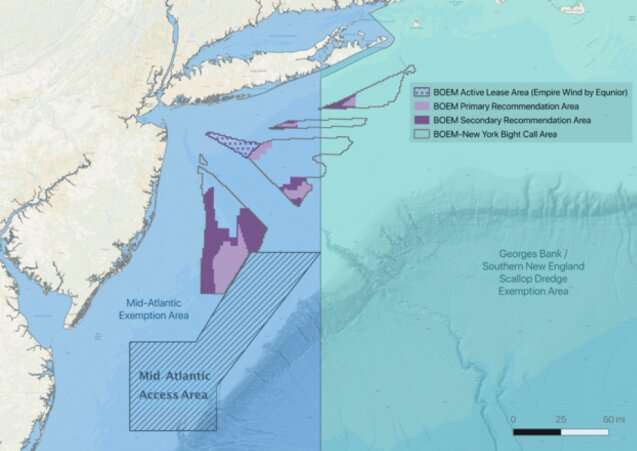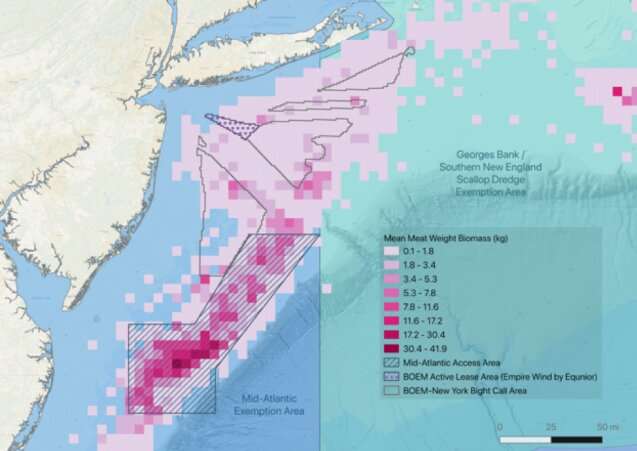Success of New York offshore wind industry depends on collaboration with scallop fishery

Offshore wind is considered one of the most promising forms of renewable energy to expand this decade. According to the nonprofit World Forum Offshore Wind, technological advancements, global government support, and cost reductions have allowed the industry to play a greater role in electricity generation. Offshore wind is currently most prevalent in Western Europe, but this source of energy production is rapidly growing in countries such as China and the United States.
In New York State, Governor Cuomo's 2018 Offshore Wind Master Plan outlines steps for offshore wind development until 2030. A first-of-its-kind document in the United States, the plan delineated a study area known as the New York Bight Call Area for the Bureau of Ocean Energy Management (BOEM), the agency responsible for energy projects in federal water, to consider for future projects. BOEM has recommended several areas of interest (see map below), and the oil and gas company Equinor secured an approximately $3 billion lease next to the area for its Empire Wind project.
While the Offshore Wind Master Plan can help New York secure 2.4 gigawatts of carbon-free electricity by 2020 (enough to power 1.2 million homes), the projects could also potentially compete with other activities, such as fishing, vessel traffic, conservation, and ocean science research. In the NY-NJ Bight, scallopers are concerned about offshore wind projects negatively impacting fisheries. Examining the spatial proximity between the region's scallop fishery and offshore wind industry highlights the need for wind development companies to take fishermen's concerns more seriously, so that both parties can coexist successfully.
The NY-NJ Bight Call Area is valuable to the Atlantic sea scallop fishery, the largest wild scallop fishery in the world. In 2016, the scallop industry generated $486 million in landings revenue. As a point of comparison, the American lobster was the top species fished in 2016, with $667 million in landings revenue.
The New England Fishery Management Council (NEFMC) and NOAA Fisheries have managed the resource under the Atlantic Sea Scallop Fishery Management Plan since 1982. Sea scallops were declared overfished in 1997, but actions to limit the amount of vessels at sea, update fishing equipment, and periodically close off certain fishing areas led to the sustainable management of the resource. Every year, the NEFMC publishes "framework adjustments" to its plan. These frameworks delineate new areas for scallopers to fish in depending on the vessels' permit. Some areas are closed off for research or to protect young scallops.
The proximity (and sometimes overlap) between rich scallop beds, scallop vessel activity, and the offshore wind proposal has provoked conflict between the two industries. In the NEFMC's most recent framework submitted in March 2020 (Framework 32), a section discusses how offshore wind energy is expected to have a negative impact on scallop habitat and fishing activity in the future.
An article in City & State notes that in 2018, scallopers and supporting advocacy groups sued BOEM for having failed to evaluate alternative options for Equinor's Empire Wind lease. While the Offshore Wind Master Plan requires wind developers to work with community, environmental and fishing groups, tensions between regional marine stakeholders persist.
Scalloper concerns can be grouped into three categories: 1) Negative effects of turbine construction and underwater grid connection on scallop habitat; 2) Risks and restricted fishing activity from wind farm infrastructure; and 3) The consequences of restricted fishing activity, which is the increased competition for the same resources within smaller areas.
For the first concern, BOEM published a report in 2015 highlighting the negative effects of wind farm construction on scallop filter feeding abilities and larval dispersal from changes in sedimentation and currents. An article for the Poughkeepsie Journal states that fishers are also worried that the process of burying connection cables into the ground will disrupt habitats. In response to this concern, an offshore wind representative said that placing the cables underground would actually help preserve fishing grounds in the long run.

There is an overall lack of information on the environmental impacts of offshore wind farms in the United States. Where the sector is more established in Northern Europe, results of ecological impact studies are still unclear and it is difficult to distinguish long-term from short-term effects.
In regards to the second concern, there are risks of vessels striking a turbine or getting fishing gear caught in underwater infrastructure, which can damage gear or capsize the boat. To address this risk, BOEM identified a five-mile wide corridor across the New York Bight for vessel traffic. For a site on the New England coast (north of the NY-NJ Bight), wind developers proposed building appropriate spacing between the rows of turbines.
Lastly, fishermen are concerned that the potential displacement of fishing activity from the wind farms could increase competition for the same scallop resources in the NY-NJ Bight and drive smaller vessels out of business. It is also worth evaluating how increased fishing activity in confined areas could affect the sustainability of the resource. Given the absence of data for the region, "perceptions" and "opinions" make up some of the literature on these issues. Nevertheless, social science studies provide key insights for policymakers and offshore wind developers to consider in their research and planning processes.
To address the conflict between the Mid-Atlantic region's scallop and offshore wind industries scientific data is needed to 1) understand the ecological impact of offshore wind farms; 2) understand the effects of offshore wind farms on vessel traffic; and 3) concretely address the concerns of the fishing community.
In essence, fishing and offshore wind energy are not at odds with each other. Green energy can contribute to a healthier environment, which is important for all fisheries. However, offshore wind represents a new use of marine resources that can disrupt existing activities. As such, this conflict represents an inefficiency in the integration process required for the industry's development.
It is also important to consider the alternatives. Offshore wind can help to solve graver issues affecting the region's valuable scallop beds, such as ocean acidification from climate change. According to the United Nations, acidification is a looming threat for ocean ecosystems around the world. Research by NOAA shows that acidic waters dissolve scallop shells, and such stress forces scallops to allocate more energy to maintaining their shells than to growth and reproduction.
In late 2019, a huge scallop die-off in the Peconic Bay was linked to a coccidian parasite. Although the victims were the Peconic Bay scallops (a species different from the Atlantic sea scallop), current research is determining whether the presence of the parasite was triggered by environmental factors like warmer bay waters linked to climate change.
While there is a risk of getting fishing equipment caught in underwater offshore wind infrastructure, the NY-NJ Bight is full of dredging spoils, industrial waste, sewage sludge and chemical weapons that scallopers can unintentionally haul onto their vessels. Offshore wind is part of a larger shift away from this poor treatment of marine ecosystems and towards more sustainable ocean and coastal management through spatially aware marine planning.
The New York State Offshore Wind Master Plan's mandate to form a strong link with the fishing community is a crucial component of the holistic solutions needed to achieve these sustainable development outcomes. Yet, this conflict suggests that greater collaboration is needed in the NY-NJ Bight area.
On this front, progress is being made: on March 11th, 2020, the NEFMC announced that one of its 12 research projects (Research Set Aside Program led by Rutgers University) will analyze the economic impacts of offshore wind energy development on the commercial sea scallop fishery. On May 20th, 2020, a $1.1 million grant was awarded to four institutions by BOEM and others to support regional fisheries studies that are important for the development of offshore wind in the Northeastern U.S.















